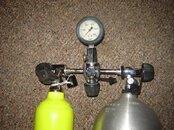halocline
Contributor
Someone ask about something similar in another post and while thinking it over I came to the conclusion you really need either a second stage or relief valves on both ends for a couple of reasons (I am assuming you are dedicating a couple of old first stages for this). First off, how are you going to bleed off the pressure when you try to remove the regs? Secondly, if the regs are OK everything would be fine but what if the IP on one or both regs goes high? You could end up with HP side pressure on the LP side. This is surely going to blow out a diaphragm or piston Orings at a minimum if not something more dramatic. For safety’s sake, IMO some form of pressure relief is needed on both ends as well as a means of depressurizing the regs when the transfer is done.
You only need one 2nd stage on one reg to depressurize. When you depressurize one, both HP chambers empty because they're connected via the hose. What could happen, I suppose, is that IP could get "trapped" in the IP chamber of the reg with no 2nd stage, then the next time you loosen a port plug, you'll get a little air releasing. That has happened to me before, it just wasn't until now that I figured out why that 1st stage sitting in my drawer had some pressure in the IP chamber one day.
Regarding using a 2nd stage on both 1st stages in case of a HP seat failure/IP spike, it's not a bad idea, but on mine, if that were to happen, there would just be a massive leak at the piston head o-ring, at least I don't think that o-ring could handle 3000 PSI!
I use this set up with one 2nd stage all the time, but as I said, your suggestion of two for the protection of each 1st stage is not bad one at all.







